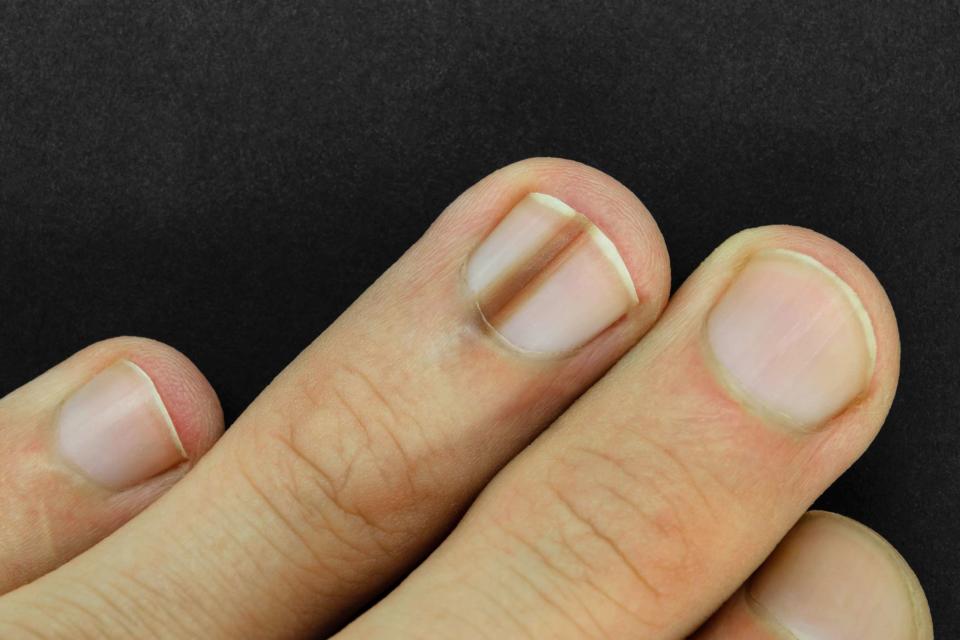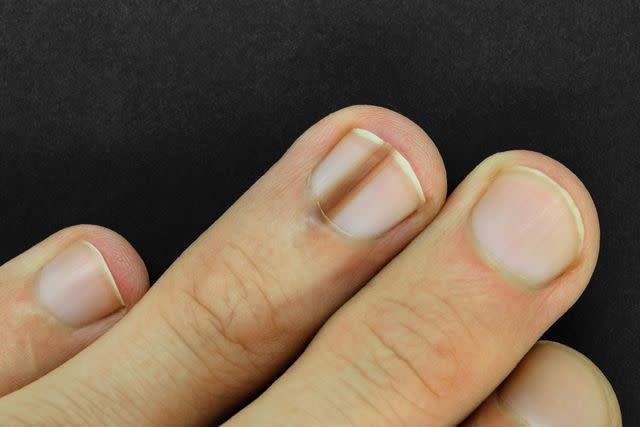What to Know About a Black Line on the Nail
Possible Causes Include Injury or Various Health Conditions

Rytis Bernotas / Getty Images
Medically reviewed by Susan Bard, MD
A black line on the nail could be normal, such as when it is just a color variation. Other possible causes range from injury or taking certain medications to various health conditions like human immunodeficiency virus (HIV) and melanoma.
Even though a black line on the nail could be something minor or normal, you shouldn’t ignore changes in your nails.
This article will dive into the details of each cause of a black line on the nail, plus explain other symptoms that may accompany it, diagnosis, treatment, and when to seek medical care.

Rytis Bernotas / Getty Images
What Causes a Black Line on the Nail?
Black lines on a nail could mean many things. It may be a normal color variation, but other things can also cause it. These include injury, medication side effects, and health conditions.
Melanonychia
Melanonychia is the most common cause of a black line on a nail. This condition is characterized by black or brown discoloration of the nail plate. It can affect just one nail or multiple nails on the fingers and toes. It accounts for nearly half of all cases of nail discoloration.
There are several types of melanonychia, each with its own common causes. These include:
Longitudinal melanonychia (running vertically on the nail bed, in the direction of nail growth): Caused by lentigines (liver spots), moles, and melanoma
Total melanonychia (covers retire nail bed): May occur in people with dark skin pigmentation or be caused by medications or infection
Transverse melanonychia (runs horizontally across the nail bed): Caused by medications
While each has distinct causes, melanonychia happens when your skin overproduces melanin (skin pigment) or melanocytes (pigment cells).
Injury
When your nail endures trauma from a hit, pressure, or even nail biting, a splinter hemorrhage may result. This area of bleeding under the nail resembles a splinter (thus the name). These injuries run in the direction of nail growth (vertically).
Medications
Some medications can also cause a black line on the nail. These medications may include:
Chemotherapy used to treat cancer
Antiretroviral therapy used to treat HIV/AIDS
Antimalarials used for malaria treatment
Biologics used to treat arthritis and other inflammatory conditions
Dilantin (phenytoin), a seizure medication
Lamprene (clofazimine) to treat leprosy
Psoralens used in light therapy for skin conditions
Remicade (infliximab) for treating Crohn's disease, an inflammatory bowel disease (IBD)
Antifungals, including fluconazole and ketoconazole
Cyclins for breast cancer treatment
Phenothiazines for mood disorders
Sulphonamides found in some antibiotics
Of these, the most common cause of drug-related black lines on the nail is chemotherapy.
HIV
HIV can cause nail changes, including black lines on the nails. The virus itself may cause these nail changes, as can medicines used to treat HIV. If the black line on your nail is due to your medication, symptoms usually occur soon after you begin treatment.
Melanoma
Melanoma, a serious form of skin cancer, can cause a black line on the nail. According to the American Academy of Dermatology Association (AADA), the following are symptoms of melanoma of the nail:
Brown or black band on the nail
Often appears on the thumb of your dominant hand or the big toe but can appear on any nail
Dark skin around your nail
Nail lifting from your finger or toe
Nail splitting
Bump under the nail
The AADA recommends performing routine skin checks to look for any signs of skin cancer, including on and around your nails.
Related: Subungual Melanoma: Causes, Diagnosis, and Treatment
Endocarditis
When black lines appear on multiple nails, it tends to point to a systemic (body-wide) cause rather than an injury. One example of a health condition that could lead to black lines on multiple nails is endocarditis, a bacterial infection in the heart.
Black lines on the nail occur with endocarditis due to damaged blood vessels. They are called splinter hemorrhages.
Fungal Infection
A fungal nail infection can also cause longitudinal melanonychia. While rare, Candida infection of the nail (a fungal infection caused by a yeast) can sometimes present with a black line. It can sometimes mimic melanoma. A fungal infection can be confirmed with a nail biopsy (taking a sample to examine in the lab) or culture.
Nail Psoriasis
Psoriasis (an autoimmune skin condition) can sometimes present with a black line on the nail. In addition, nail psoriasis can cause nails to split, lift away from the nail bed, and lead to itching and thickening. About 70% to 80% of people with psoriasis have it on their nails.
Other Symptoms
In addition to a black line on the nail, other symptoms may co-occur, depending on what is causing it. These symptoms may include:
Pain and swelling (in the case of injury)
Other common medication side effects, like gastrointestinal problems, dizziness, headaches, or a rash (if caused by drug side effects)
Dark skin around your nail (in the case of melanoma)
Nail lifting from your finger or toe (associated with cancer, infections, and psoriasis)
Nail splitting (associated with cancer, infections, and psoriasis)
Bump under the nail (associated with cancer)
Chest pain (with endocarditis)
Coughing (with endocarditis)
Fever (with endocarditis)
Sore muscles (with endocarditis)
Skin issues (with endocarditis and psoriasis)
Related: Nail Psoriasis vs. Fungus: What Are the Differences?
How Lines in Fingernails Are Diagnosed
Since so many factors can cause a black line on a nail, a healthcare provider will do a physical exam and take a thorough medical history. Be prepared to share the following:
How long you have noticed the symptom
Whether any other symptoms accompany it
Any injuries or trauma on your hands or feet
Any medications you take
Any health conditions you have
Any health conditions your family members have
Once a healthcare provider understands your symptoms and health history, they may be able to narrow down some possibilities. They may order diagnostic tests like a nail biopsy and blood tests to confirm their suspicions. If a healthcare provider suspects endocarditis, they may also order a chest X-ray, an electrocardiogram (ECG or EKG), or an echocardiogram.
Black Line on Nail Treatment Options
Treatment of a black line on a nail depends on the cause. In many cases, your nail will not require treatment, and the black line will go away on its own.
However, the underlying condition needs to be addressed in the case of a health condition. In the case of medication, a healthcare provider may recommend discontinuing or changing your prescription. Do not adjust or stop your medications without consulting a healthcare provider.
When to See a Healthcare Provider
Anytime you notice changes to your nails, especially without an apparent cause, like an injury, it's essential to get it checked out by a healthcare provider. This is especially true if you have other symptoms that could indicate a health condition.
Summary
Many things can cause black lines on nails, including infections, injury, health conditions, and medications. If a health condition causes the black line on your nail, you may also experience other symptoms that correlate with that health condition. Similarly, if medications cause it, you may notice other medication side effects.
A healthcare provider will do a physical exam and order some diagnostic tests to diagnose the black line on your nail. You may not need treatment, but if a health condition causes the black line on your nail, treatment involves addressing the underlying cause.

